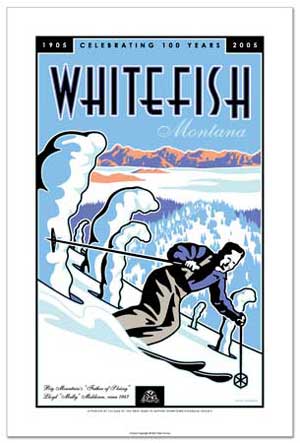WHITEFISH – Drawing and skiing. Pete Thomas has always had an affinity for both. His love of illustration started when he was a kid doodling all over school folders. Skiing was just a natural pastime for a boy growing up in the mountains outside of Denver.
Wherever Thomas landed, like Whitefish 16 years ago, he remained a skier and artist, and this past year he was given the opportunity to blend both lifelong passions into one viable business pursuit.
The 41-year-old artist has started designing skis for one of the sport’s pioneering companies, HEAD. Thomas illustrated the top sheet artwork for HEAD’s Peak series, which debuted this winter. Thomas, a graphic designer at ZaneRay Group, a full service design and website consultancy company in Whitefish, stayed true to his background as an illustrator who is influenced by vintage style. The result fit right in with HEAD’s classic design and the company contracted him to continue designing future models.
“He’s been able to deliver some great looking stuff to us,” Jon Rucker, vice president of winter sports at HEAD, said. “We’re really psyched.”
Founded in 1950 and known for evolving the ways skis were developed, HEAD appears to be a perfect partner for Thomas. Local residents probably recognize his name from the bottom corner of some of the more iconic local posters. Released over the last decade, his Whitefish centennial series and Glacier National Park series are popular prints that blend classic art deco with a modern graphical scheme. The posters pay homage to, and draw inspiration from, the original screen print commercial art developed in the mid-1900s, like the Work Projects Administration posters.
“That type of design is high impact design,” Thomas said. “That’s why these older posters still resonate today because they’re so classic and iconic.”
“I enjoy that type of art because it does, to me, have a lot of impact,” he added. “It is visually arresting. It stops the viewer. That’s always going to be one of my first objectives with the work I create, is to really arrest the viewer so they do stop and look.”
His life as an artist has followed an evolutionary cycle beginning with those early childhood sketches. He graduated from doodling to studying graphic design in college and spent years focusing his talents on brochures, ads and other commercial work. He continued working as a traditional graphic designer after moving to Whitefish in 1996 before focusing on more illustration-based artwork.
“I want to create something that sticks around,” he said. “I want to create something that will have more mileage but also collectively can hopefully stand the test of time.”
Thomas studied prints that inspired him, like those produced by the Work Projects Administration. He noticed how they all successfully and imaginatively depicted a place and moment frozen in time. His posters have the same aim, depicting a skier riding past snow ghosts on Big Mountain, or a couple strolling through downtown with mountains in the backdrop.
 |
|
Whitefish Centennial poster created by Pete Thomas. |
“With these vintage pieces I’m trying to really authentically capture these snapshots of time where it’s a representation of a particular place, of possibly an event happening, a very particular period of time,” he said.
He appears to have achieved his goal, both with his posters and now with skis.
“He truly is talented,” Rucker said. “Through the years I’ve looked at his art, not just commercially but what he’s done personally, and it’s a very classic, bold style that really matches very well with our brand in terms of sort of embodying visually what we’re about. So it was a natural fit.”
Rucker and Thomas became friends through skiing and have now known each other for almost 13 years. Thomas submitted his work along with other artist candidates and was selected by HEAD independent from his relationship with Rucker.
“Pete’s stuff was really well liked by all the folks here,” Rucker said. “It was a very quick and easy decision to pull him in.”
The match was a dream come true and “a perfect marriage of both my ski background and my design work,” Thomas said.
Designing skis was far from an arbitrary process, Thomas said. In line with his own style, as well as HEAD’s, Thomas approached the skis with a similar mindset as he does a poster.
“You literally need to stand in the boots of the person who is going to be skiing these skis and you have to imagine and understand what resonates with them,” he said. “What are their interests? What is the demographic? How do they make decisions? What compels them?”
Thomas spent over six months designing the Peak series and last year he was able to finally try them out on the slopes. The moment was surreal, he said.
“Every once in awhile I would look down and chuckle about it and pinch myself,” he said.